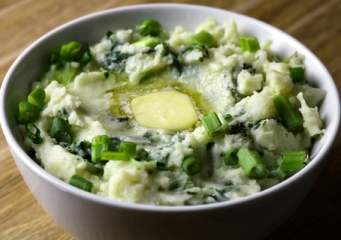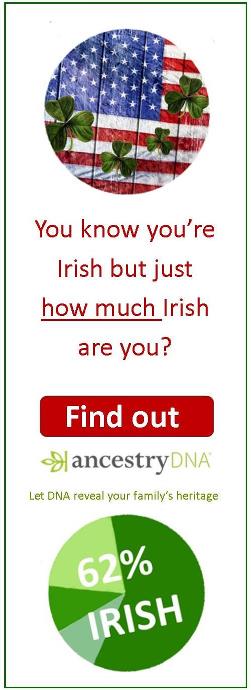- Home ›
- Traditional Irish food ›
- Colcannon
Colcannon Recipe
Everyone's favourite Irish potato recipe – enjoy on its own or with boiled ham
Everyone's favourite Irish potato recipe
The Colcannon recipe below marries Ireland's favourite vegetables – potatoes and cabbage. It's appropriate, then, to find some customs that brings together Colcannon and marriage.
 Colcannon: Makes me hungry just thinking about it!
Colcannon: Makes me hungry just thinking about it!One such tradition had a young woman blindfolded and sent out into the cottage garden to select a cabbage. Returning to the home, the root of the vegetable is then examined and its characteristics are taken as predictions of her future husband. (Too bad if she selected a cabbage with a withered, short, hairy, dirty root!)
After preparing the recipe below, she would hide a ring inside a large bowl of Colcannon and present the dish to a large family or community gathering.
Each diner in turn would take a spoonful of the vegetables. The one who found the ring would be the next to marry.
No doubt the qualities of the root she had looked at earlier would determine how happy she was with the outcome of this meal!
Colcannon remembered
Did you ever eat Colcannon
when 'twas made with yellow cream
and the kale and praties blended
like a picture in a dream?
Did you ever take a spoonful
and dip it in the lake
of clover-flavoured butter
that your Mammy used to make?
Oh God be with the happy days
when troubles we had not
and our Mammies made Colcannon
in the little skillet pot.
Another custom, well-practised in many parts of the island, was for
the first and last spoonfuls of a Colcannon meal to be placed inside a
young girl's stocking.
This was then hung from a nail in the door of her home. The first man to enter would be her future husband.
Colcannon remembered
Did you ever eat Colcannon
when 'twas made with yellow cream
and the kale and praties blended
like a picture in a dream?
Did you ever take a spoonful
and dip it in the lake
of clover-flavoured butter
that your Mammy used to make?
Oh God be with the happy days
when troubles we had not
and our Mammies made Colcannon
in the little skillet pot.
Possible the earliest reference to the dish comes from a 1735 publication when it was described as a Halloween supper in Dublin and was followed by apples and nuts. It would probably have been served with parsnip in the mash, as that is the tradition in counties Dublin, Wicklow and Wexford.
In the Colcannon recipe below, however, I have not added this vegetable.
Ingredients
- 3lbs (1.5kg) potatoes, floury variety
- 1lb (500g) cooked curly kale or savoy cabbage, finely shredded
- 2oz (25g) butter
- ½ pint milk (full fat) or single cream
- 6 scallions/spring onions, chopped.
Method:
Peel and boil the potatoes until very tender. Drain and mash them until they are smooth. Add scallions to the milk in a small saucepan and bring to the boil. Add the milk and scallions to the potato mash and beat well until fluffy.
Mix in chopped cabbage (traditionally, this should have been boiled in water with a piece of bacon fat or a pig's trotter) and half the butter. Serve in individual bowls, making a well in the centre of each serving and dropping in a knob of butter.
Preparation: 15 mins. Cooking time: 20 mins.
The above quantity of Colcannon can be served as an accompanying vegetable (for 6-8) or as a main dish.
For the busy cook, the good news is that it can be cooked in advance and reheated in the oven at 180C, 350F, gas 4, for 20 mins.
The potato and the Irish
Tradition has it that the first potato was planted in Ireland in 1585. Within only a century and a half it had become the staple of the Irish. The crop had many advantages. As little as half an acre of land could feed a family, and, more importantly, provide nearly all the nourishment it needed. An average Irishman ate up to 10lbs of potatoes every day. This, together with a cup of buttermilk at each meal, plus some occasional fish and eggs, was a near perfect diet in terms of vitamins, calcium and protein.
Related Pages

